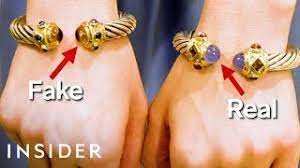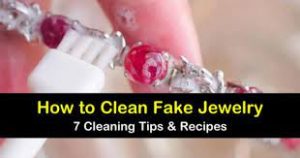
7 Ways to Tell the Difference Between Real and Fake Jewelry
- Roger
- 0
- on Nov 30, 2022
7 Ways to Tell the Difference Between Real and Fake Jewelry
When it comes to jewelry, it’s important to be able to tell the difference between real and fake. Unfortunately, there are a lot of fake pieces out there masquerading as the real thing. Here are seven ways you can tell the difference:
1. Look at the weight of the piece. Real gold is heavy, so if a piece feels light, it’s likely not real.
2. Check for hallmarks. These are small markings that indicate what metal the piece is made of and its purity. If you don’t see any hallmarks, that’s a red flag.
3. Examine the prongs. On real jewelry, the prongs should be smooth and well-formed. If they’re rough or pointy, it’s probably fake.
4. Look at the back of the piece. Real jewelry will have a smooth, finished back while fake jewelry will often have a rough or unfinished back.
5. Inspect the clasps and closures. These should also be smooth and well-made on real jewelry.
6. Ask about the return policy. Most reputable jewelers will offer a lifetime warranty or at least a 30-day return policy on their products. If a store doesn’t offer this, beware!
7. Get an appraisal from a qualified jeweler before making any big purchases. This way you’ll know for sure whether or not what you’re buying is the real deal
how to clean 14k gold jewelry at home
When it comes to 14k gold jewelry, there are a few things you need to keep in mind in order to clean it properly. First and foremost, avoid using harsh chemicals or cleaners on your jewelry as this can damage the finish. Instead, opt for a mild soap and water solution. Simply mix a small amount of dish soap with warm water and gently scrub your jewelry with a soft cloth. If you have stubborn dirt or grime build-up, you can soak your jewelry in the soapy water for a few minutes before scrubbing.
Once you’ve cleaned your jewelry, be sure to rinse it thoroughly with clean water. You don’t want any soap residue left on the surface as this can cause irritation or skin reactions. To dry your jewelry, simply Pat it down with a soft cloth or allow it to air dry.
And that’s it! With just a few simple steps, you can easily clean your 14k gold jewelry at home.
Look for a stamp: Most real gold jewelry will have a stamp that indicates the type of gold it is.
There are different types of gold stamps that indicate the percentage of gold in the jewelry. The most common stamp is “18K” or “750”, which means that the jewelry is 18 karat gold or 75% pure gold. Another stamp you might see is “14K” or “585”. This means that the jewelry is 14 karat gold or 58.5% pure gold.
If you see a stamp that says “24K” or “999”, this means that the jewelry is 24 karat gold or 99.9% pure gold. This is the highest purity of gold and is usually found on coins rather than jewelry.
Check for wear and tear: Fake jewelry is often made with lower quality materials that are more likely to show wear and tear over time.
If you notice that your fake jewelry is looking worn or damaged, it’s probably not going to last much longer.
Take a close look at the clasp: One way to tell if a piece of jewelry is fake is to take a close look at the clasp.
If the clasp looks flimsy or cheaply made, it’s likely that the rest of the piece is also not up to par.

Look for irregularities: Another way to spot fake jewelry is by looking for irregularities in the design. If a piece looks like it was mass produced without any attention to detail, it’s probably not genuine.
Inspect the clasps and findings: Higher quality gold jewelry will have more secure clasps and findings.
Look for karats: The “karat” of gold indicates its purity. The higher the karat, the more pure and expensive the gold.
Consider the weight: Another indication of quality is weight. Higher quality gold will be heavier than lower quality gold.
Inspect the craftsmanship: Take a close look at the piece to assess the level of craftsmanship. Higher quality pieces will have intricate details and precise construction.
Look for irregularities: Fake jewelry is often mass produced, so it is less likely to be perfectly symmetrical.
In addition, fake jewelry is often made from lower quality materials, so it may not have the same luster as real jewelry.
Look for hallmarks: Most real gold and silver jewelry will be stamped with a hallmark that indicates the purity of the metal. If you see a piece of jewelry without a hallmark, it’s more likely to be fake.
Check for weight: Real gold and silver are heavy metals, so fake jewelry is often much lighter.
Compare prices: Real gold jewelry tends to be more expensive than fake gold jewelry.
This is because real gold jewelry is made with pure gold, while fake gold jewelry is usually made with cheaper metals that are simply plated with gold. While real gold jewelry may cost more upfront, it will last longer and retain its value over time. Fake gold jewelry, on the other hand, will quickly lose its plating and look like a cheap piece of metal. So in the long run, real gold jewelry is a better investment.
Ask an expert: A qualified jeweler should be able to quickly tell you if a piece of jewelry is real or fake.
If you’re not sure whether a piece of jewelry is real or fake, the best thing to do is ask an expert. A qualified jeweler should be able to quickly tell you if a piece of jewelry is made from real precious metals and stones, or if it’s a fake. Keep in mind that even some real pieces of jewelry may not be worth much, so it’s always good to get an appraisal before selling any jewelry.
Use a magnet: Gold is not magnetic, so if a piece of jewelry is attracted to a magnet, it is most likely not real gold.
If you don’t have a magnet, you can use acid test: Another way to tell if your jewelry is real gold or not is to do an acid test. You will need a touchstone and some hydrochloric acid for this test. First, make a small scratch on the surface of the gold with the touchstone. Second, add a drop or two of hydrochloric acid to the scratch and wait for a reaction. If the gold is real, there will be no reaction. If the gold is fake, it will turn green where it was scratched by the touchstone.
how to identify unmarked costume jewelry
If you’re not sure if a piece of jewelry is real or fake, there are a few things you can look for to help you tell the difference. Here are 7 ways to tell the difference between real and fake jewelry:
1. Look for a hallmark. Hallmarks are small stamps on the inside of a piece of jewelry that indicate what metal it is made of. If there is no hallmark, the jewelry is likely made of cheaper metals like brass or copper.
2. Examine the clasps and findings. Real gold and silver jewelry will have clasps and findings made of the same metal as the rest of the piece. If the clasps and findings are made of cheaper metals, it’s likely that the whole piece is fake.
3. Check for wear and tear. Fake jewelry is often made with cheaper materials that are more prone to wear and tear. If a piece of jewelry looks like it has been well-worn, it’s more likely to be fake.
4. Inspect the stones. Real diamonds and other precious stones will have slight imperfections, known as inclusions. Fake stones are often perfect in appearance, with no inclusions at all.
5. Hold it up to the light. Real gold and silver will be opaque when held up to the light, while fake gold and silver will be translucent.
6. Look at the price tag. If a piece of jewelry is very cheap, it’s